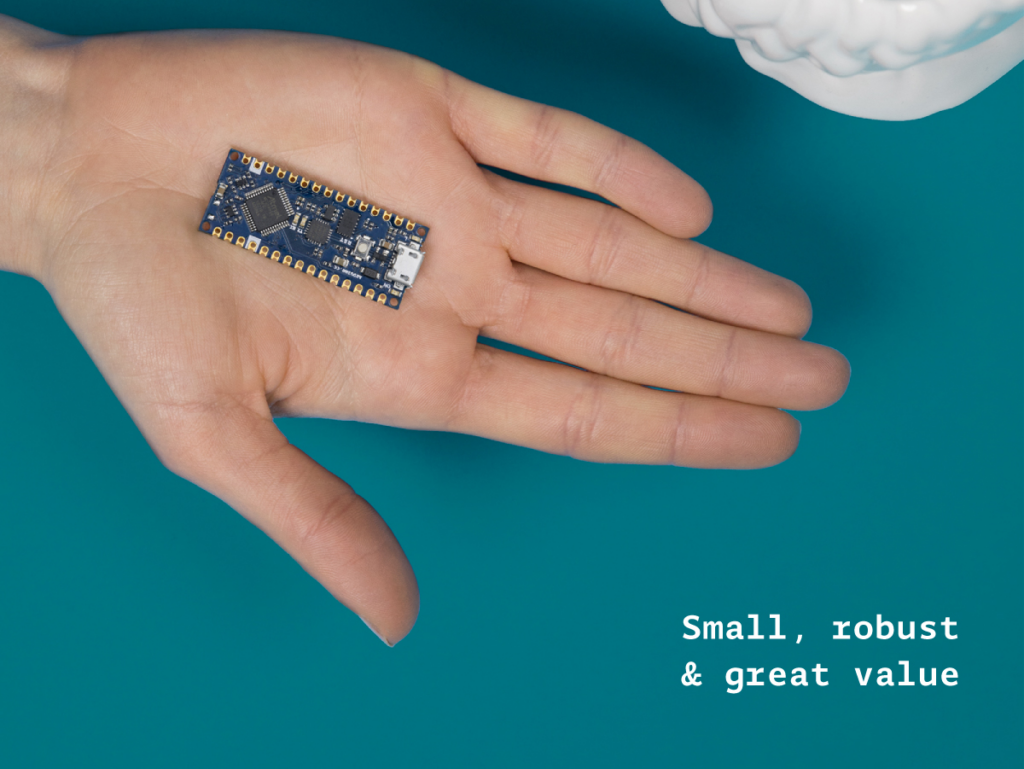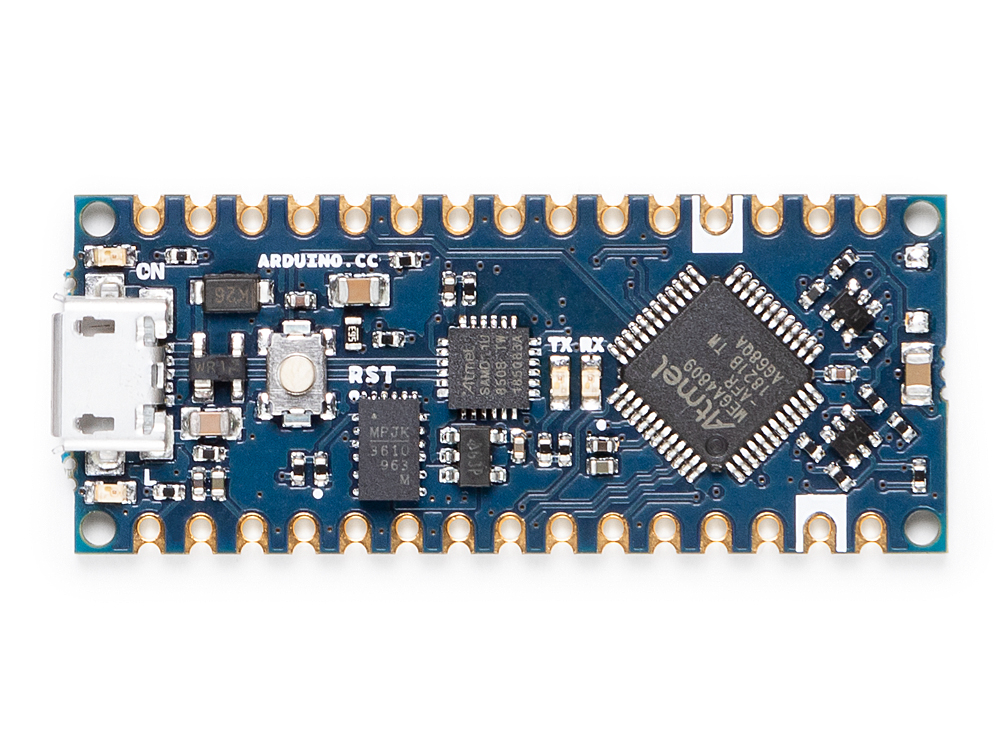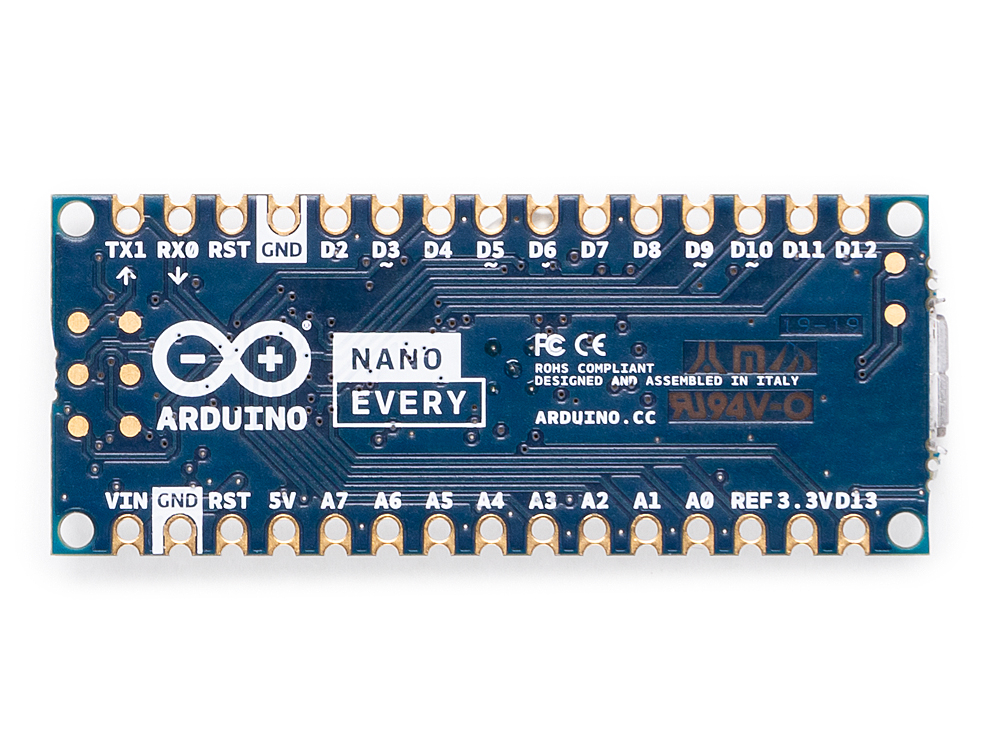Deep dive with Dario: Get to know the Arduino Nano Every

The original Arduino Nano occupies a special place in many makers’ hearts. The tiny footprint (48×18 mm — around half a stick of gum), reliability and tons of examples makes the Nano perfect for wearables, drones — in fact any project made to last.
The Nano is back! The new entry-level Arduino Nano Every manages to pack in even more features at an even lower price — just $12.50 / €11.40 without headers — and is backwards compatible with the original. Dario Pennisi led the development of the board, so we sat down with him to learn more.
Why did you decide to create the Arduino Nano Every?

The size of Arduino Nano Every makes it ideal for wearable projects; in experiments, in prototypes or in a full cosplay setup! Sensors and motors can be connected without too much fuss which means it’s great for robotics, drones and 3D printing, too.
Searching for “Arduino Nano project” returns millions of results for the original. But you also find people complaining about boards not working. Of course, those boards are usually clones — not genuine Arduino boards! Clones can have reliability issues which mean you need to pay for more, or are frustrated trying to get them to work.
So this is why we made the Arduino Nano Every. It’s reliable, affordable and more powerful. The newer ATmega4809 microcontroller fixes limitations of older ATmega328P-based boards — you can add a second hardware serial port! More peripherals and memory means you can tackle more ambitious projects. The Configurable Custom Logic (CCL) is a great way to get beginners more interested in hardware. We’ve used a quality USB chip so people won’t have connection or driver issues. The separate processor handling the USB interface also makes it possible, using a custom firmware, to implement different USB classes such as Human Interface Device (HID) instead of just the classic CDC/UART.
So not only is it a great choice for makers — in buying a genuine Arduino they will be supporting us in continuing to contribute to open source for the whole community to benefit from.
Can you tell us the three key features of Nano Every?

- New processor with more memory and new peripherals, still 5V capable. The added memory will unleash creativity and open to more complex applications and the new peripheral set, which includes a second serial port, will finally allow communicating at the same time with a PC and with peripherals such as a wireless interface or a GPS.
- The new power supply architecture based on a high efficiency DC-DC converter allows powering the board at up to 21V and to drive output peripherals with up to 950mA without overheating.
- Castellated contacts and flush bottom side allow soldering the Nano Every directly on a board as a traditional SMT component, opening the possibility to reduce final product size and helping the use in volume applications.
So the processor is the same as the Uno WiFi R2 and it has more Flash and more RAM. The sketches made for the Nano are going to run on the Every as they are? Is it truly a replacement with zero modification in any Nano based project? Please elaborate.
Actually the ATmega4809 we use on the Uno WiFi R2 and Nano Every is not directly compatible with ATmega328P; however, we’ve implemented a compatibility layer that translates low level register writes without any overhead so the result is that most libraries and sketches, even those accessing directly GPIO registers, will work out of the box.
Why you decided to offer the board with no headers supplied or soldered in the basic package?
Not only are new Nano boards are offered without headers, they all are totally flat on the bottom side and offer castellated pads on the sides, so you can actually solder them on your PCB as a standard SMT component using a normal pick and place machine.
The price is really aggressive, did you compromise on Arduino quality standards to achieve this?
We’ll never give up on Arduino quality standards and we’re still manufacturing in Italy making sure that our ethical values are strictly followed. The lower price point on these products has been achieved thanks to a careful optimization on purchasing prices and by trimming our margins as we believe that it’s important to give makers the quality they deserve at competitive prices.
The Arduino Nano Every is now available for pre-order on the Arduino online store with headers (estimated shipping date: end of July 2019) or without headers mounted (estimated shipping date: mid-June 2019).
June 1st, 2019 at 15:33:47
Where can we find technical information, including schematics and mechanical drawings?
June 4th, 2019 at 13:24:48
It would be great to have the layout of the SMD-pads onto which you can solder the Nano Every. Are all VIAs insulated? Or do we need to avoid routes around the vias?
June 16th, 2019 at 18:50:21
When powered by usb or vin, does the chip and interface run at 5v or 3.3v?
June 19th, 2019 at 13:55:42
With this board, is it possible to use the UPDI feature of the microcontroller?
June 20th, 2019 at 15:21:20
@blackketter Schematic and layout will be released once the board will be available on the store. Please be a little bit more patient ?
@FloGer all vias are covered. We will publish the footprint or you will get it from the design files. On the bottom there are test points for USB, UPDI and SWD for the D11. We use those TP during the production phase but obviously they can also be used when used as a module!
@bobqat yes. You have to solder a wire or a 3×2 and headers on the back test points. There there are the 3.3V signals to program and debug the D11 and the 5V updi signal. The UPDI is driven by the D11 during the upload phase and release when acting as serial bridge
@wavedebb the main processor (4809) runs at 5V while serial bridge (D11) at 3.3V with voltage translators. When you plug usb as in the original nano you drop a bit on a diode.
June 25th, 2019 at 17:21:01
Je viens de recevoir mes arduino nano every mais lors du televersement de sketch j’ai ce message qui s’affiche : avrdude: jtagmkII_initialize(): Cannot locate “flash” and “boot” memories in description
Les sketch fonctionnent bien avec un arduino uno
July 2nd, 2019 at 15:00:12
I purchased this and have nothing but problems. Days spent looking for various solutions.
Cannot even find a driver for this board.
July 2nd, 2019 at 16:42:14
Is it possible that there are more interrupts than 2 available on the nano every board?
I am using this board for a J1850 application. The two serial ports and 21 volt supply are a real game changer.
July 5th, 2019 at 11:12:52
Hi I figured out that in NANO EVERY compatibilty mode to ATMEGA328 pins: A7 and A6 were changed (converted). It is a serious problem if you want change NANO R3 witch NANO EVERY. When we expect solution for that?
July 7th, 2019 at 00:11:27
What are the pins for the second serial port ?
Thank you.
July 8th, 2019 at 16:44:20
So I am getting this when trying to upload a program to my new Arduino nano every: avrdude: jtagmkII_initialize(): Cannot locate “flash” and “boot” memories in description. What could be the cause for this?
July 13th, 2019 at 07:16:35
“The separate processor handling the USB interface also makes it possible to implement different USB classes such as Human Interface Device (HID) instead of just the classic CDC/UART.”
Are there plans to make the megaAVR board package support pluggable HID by default?
August 20th, 2019 at 13:42:09
I get the “avrdude: jtagmkII_initialize(): Cannot locate “flash” and “boot” memories in description.” ERROR . It seems I’m not the only one. The same sketch works with a Arduino Micro tho. Hope there will be fix soon.
August 21st, 2019 at 02:09:46
Doesn’t work with TimerOne library and cant find similar replacement that does work. This is a deal breaker for me. I really hope that library gets updated because I really like the concept.
August 25th, 2019 at 01:18:21
I also see the avrdude jtagmkll ERROR mentioned above but my (admittedly simple) sketches run fine, so I’m ignoring it. If someone could write up a Getting Started article with “official” advice regarding the proper Board and Registers choices, and what to expect with the the Boards Manager, that would be helpful. Loving the form factor.
December 10th, 2019 at 18:09:04
Purchased a 3-pack of genuine Nano Every boards directly from the Arduino CC store. These boards use the Atmel SAMD11U chip for USB comms. In the Arduino IDE tools menu, a proper port never appears in Tools->Port. I have researched this on countless threads, and a huge number of references to it (and “fixes” for it), none of which solve the problem. There is one mention of a fix, which appears to indicate a deprecated version (1.8.5) of the IDE. That would seem an odd way of using such a new Arduino product. Thoughts? Help?
Arduino: 1.8.10 (Mac OS X), Board: “Arduino Nano Every, None (ATMEGA4809)”
avrdude: jtagmkII_getsync(): sign-on command: status -1
December 28th, 2019 at 01:50:13
I bought 6 of these junk boards. NON of them will connect to arduino ide. I used numerous different usb cables. And nothing. Junk.
January 16th, 2020 at 14:43:55
I bought an Arduino Nano Every because on the thecnical characteristic is reported:
If you used Arduino Nano in your projects in the past, the Nano Every is a pin-equivalent substitute. Your code will still work, and you will NOT need to re-wire those motors you planned in your original design. The main differences are: a better processor, and a micro-USB connector.
Using the same code some errors occours with the IR Remote Library.
I use this code without problems on Arduino UNO rev.3 , Arduino Mega 2560 Rev3, Arduino NANO.